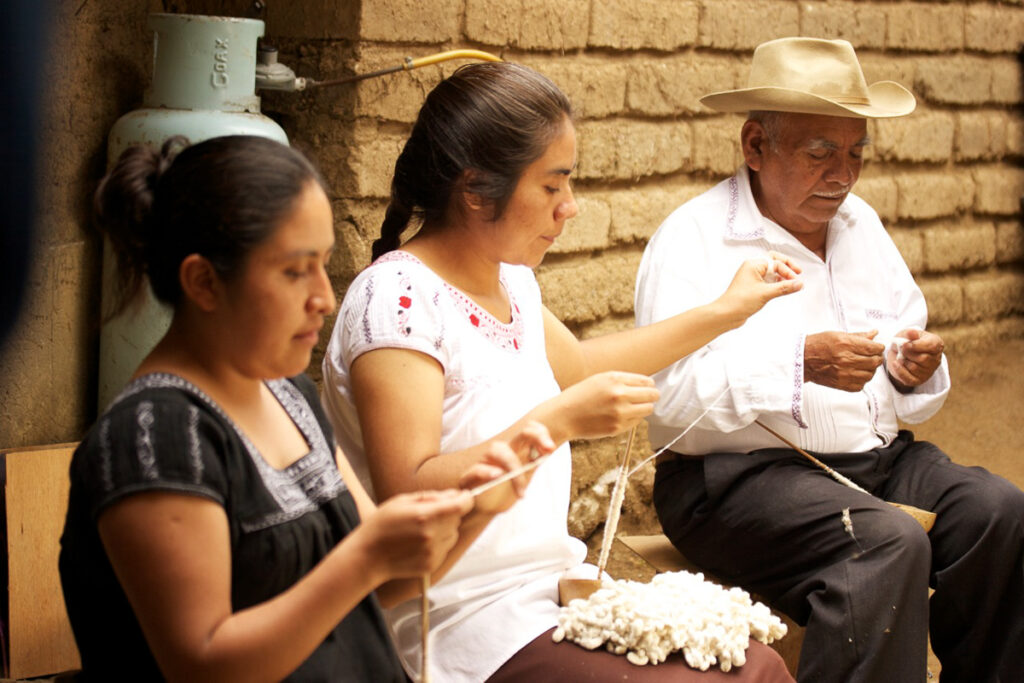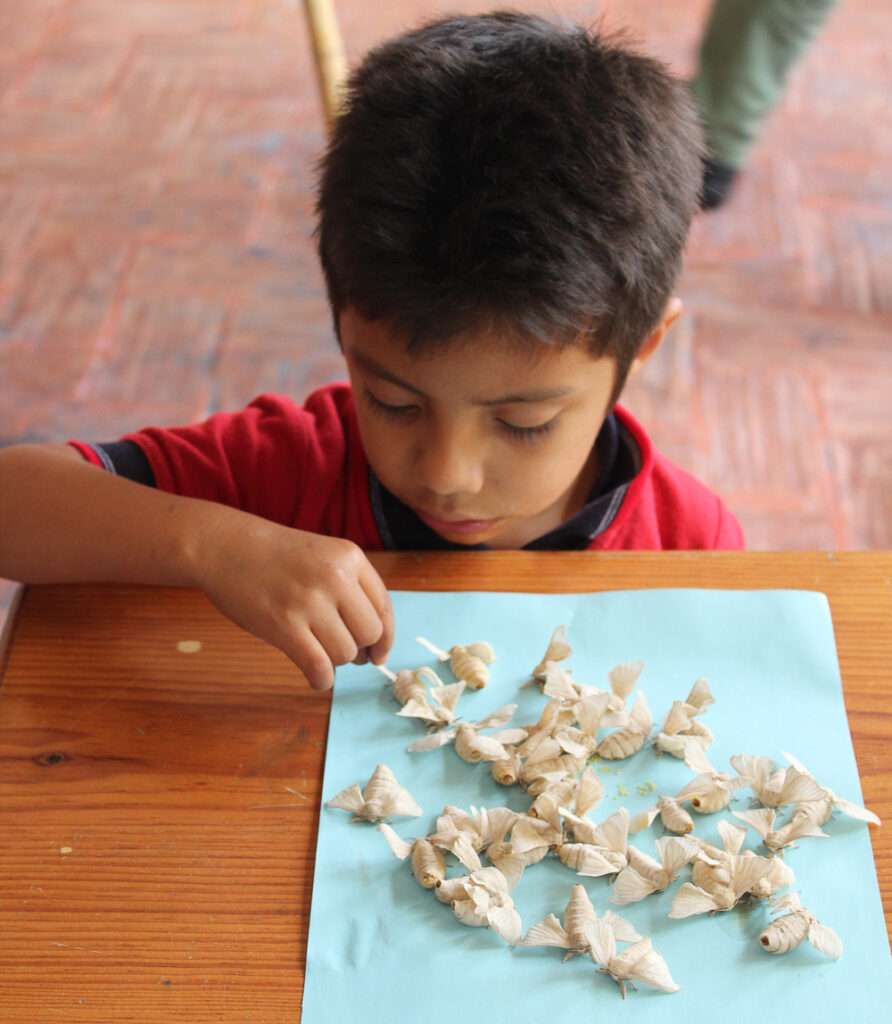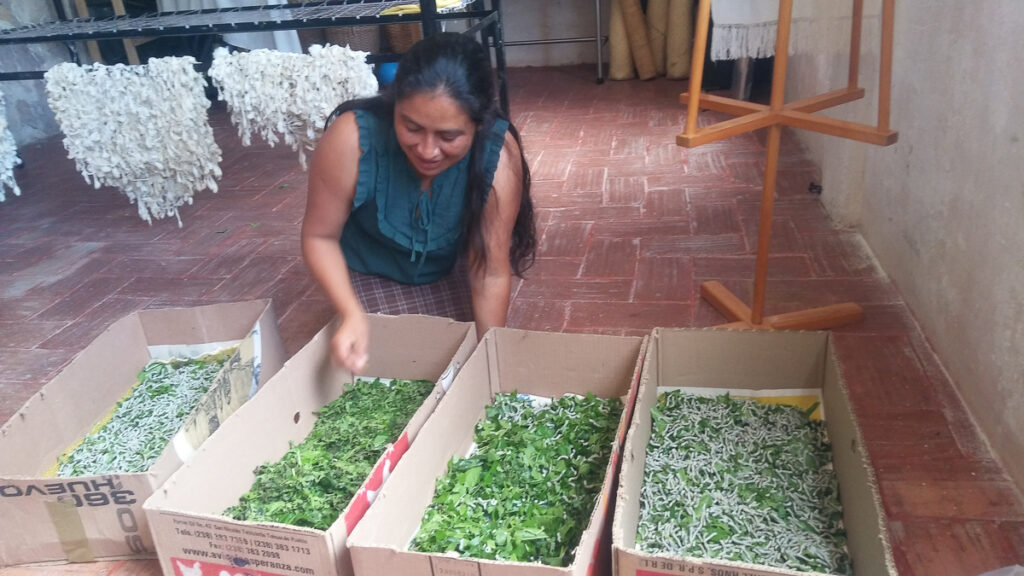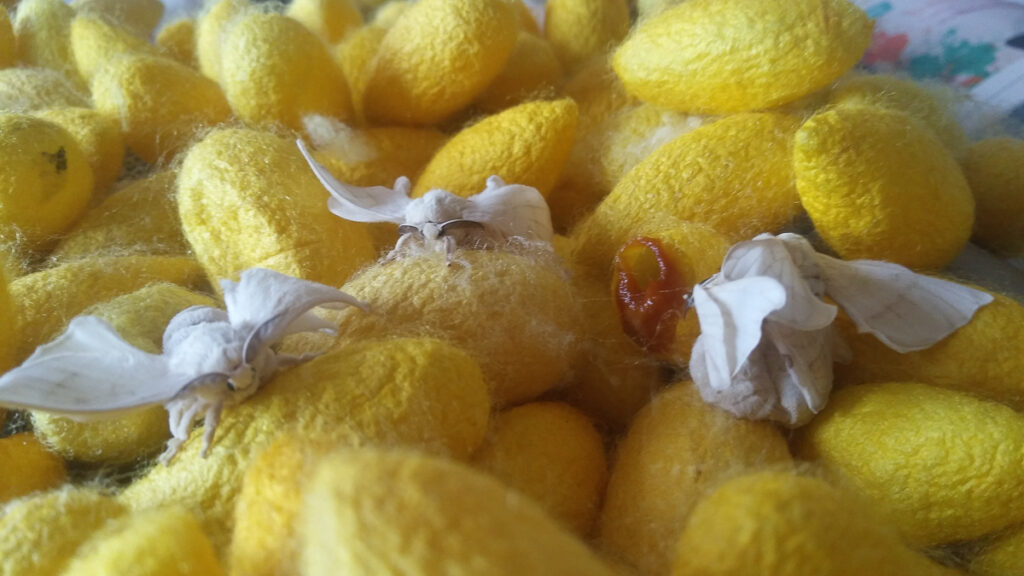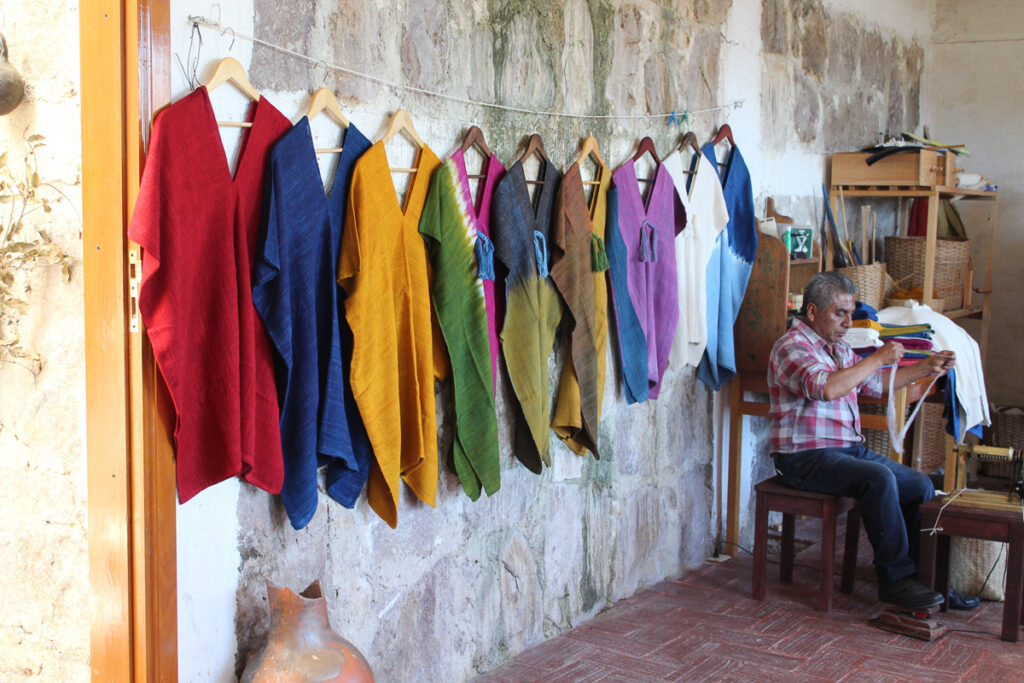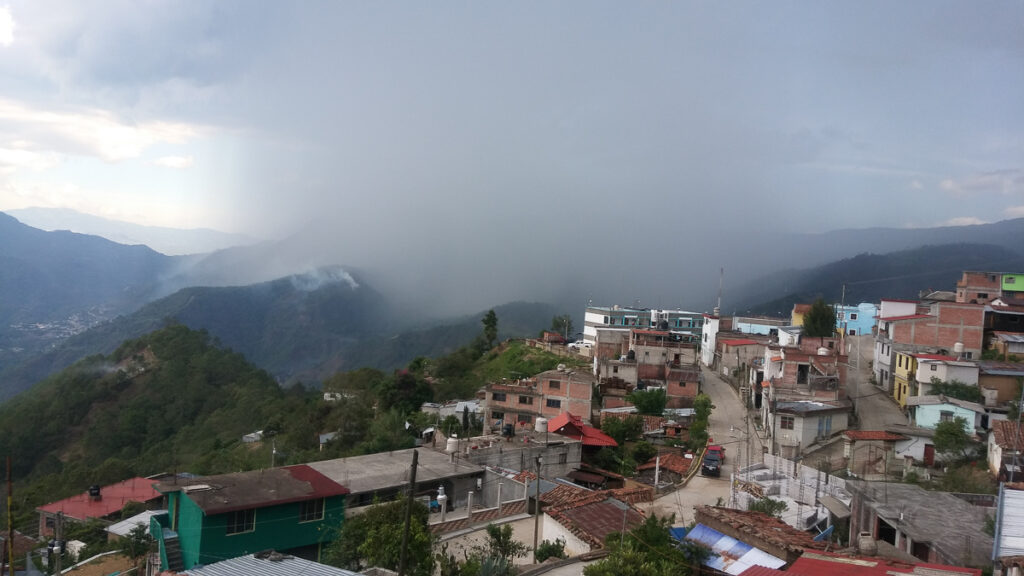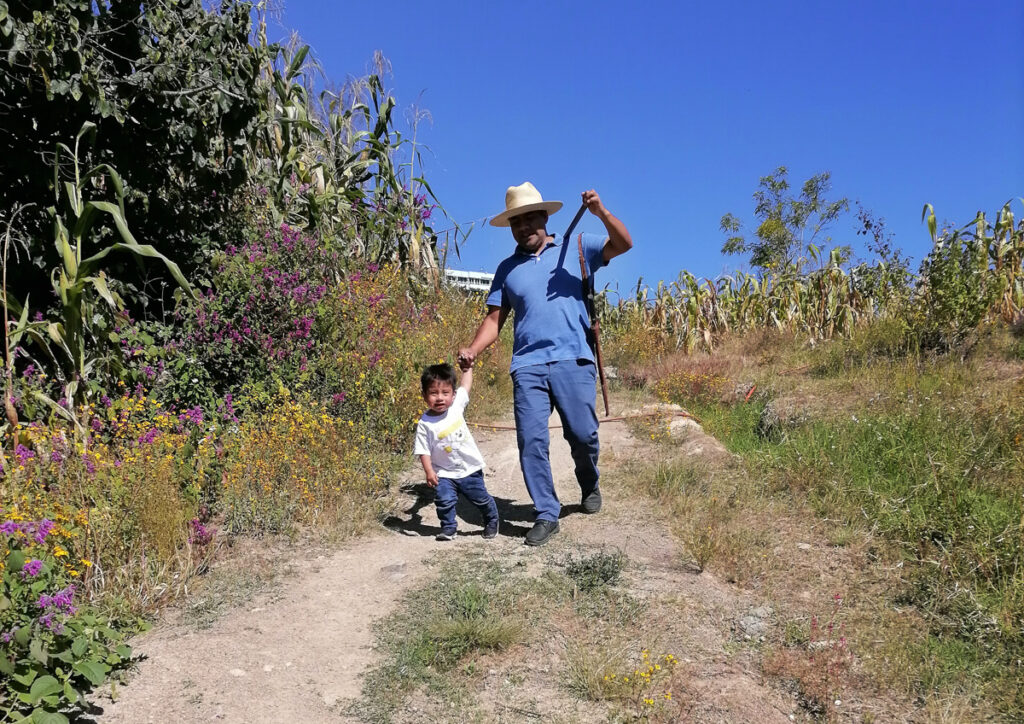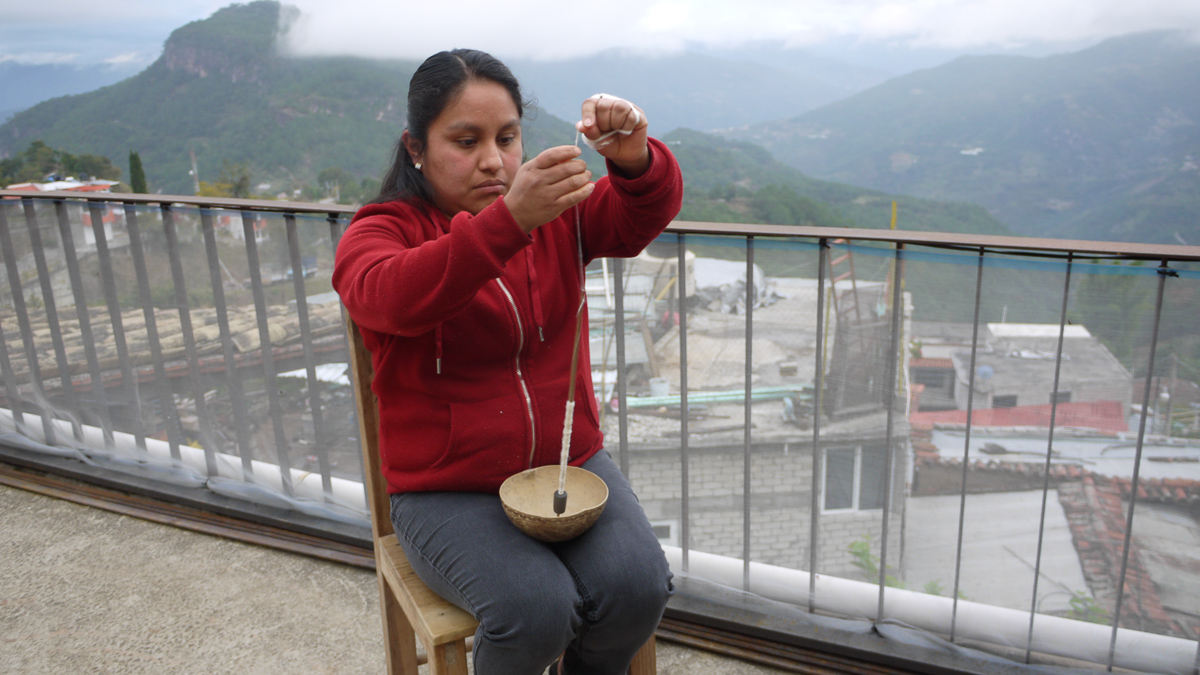
Daisy Garcia Flores, Spinning with a malacate 2019; San Pedro Cajonos Oaxaca; Photo: José Martinez Velazco
Raquel Bessudo tracks down a community of silk spinners weavers in Oaxaca, demonstrating the enterprise of their craft collectives.
(A message to the reader in Spanish.)
(A message to the reader in English.)
Artists and artisans in remote areas of Mexico are discovering how strong social media profiles and professional websites are crucial to attracting people who are searching for information or products. Rural communities’ projects now enjoy exposure thanks to their new presence on the internet, and this is how I came across silk producers in Oaxaca’s Sierra Norte region.
YouTube videos, FaceBook and Instagram profiles bring us closer to the work of artists and artisans from far-flung corners of the country such as San Pedro Cajonos. However, making contact with them—whether in person or by phone or messaging—is often far trickier because in addition to their work as artisans they are often looking after their crops and livestock.
- Gladys Garcia, Heber Martinez, Apolonio Martinez, Spinning silk 2010; photo: Vidas Entretejidas
- Isaac Martinez Garcia, thanking care of moths ovipositing of eggs Photo: José Martinez Velazco
- Gladys Garcia Flores, Fourth stage silkworms 2020 San Pedro Cajonos Photo: Idalia Martinez Martinez
San Pedro Cajonos is mainly a Zapotec community and its members learn to speak Zapoteco from an early age. Sericulture has been passed down the generations over the past 300 to 400 years. Although some documents and pieces of research refer to how the Spaniards introduced the silk industry to Mexico during the colonial era, they do not mention specific dates or names.
When the internet became available in San Pedro Cajonos just three years ago, it opened a window onto the world and became an essential source of information. The local community swiftly developed ideas about how to benefit from their newly acquired connectivity. But the Covid pandemic frustrated their marketing and sales strategy during the first six months of 2020: all trade fairs were cancelled, tourism dried up, and shops shut their doors in the city of Oaxaca (the nearest urban centre). This combination of factors threatened to force them to shelve their plans entirely.
Eventually, they decided to concentrate on the time-consuming process of silk production and on developing the silk sanctuary project. Capitalising on their new WiFi connections and specialist knowledge, they seized the opportunity to connect to a broader audience, sharing photos and videos for clients to appreciate the work’s quality, thus building trust among their new customers. Nevertheless, connectivity remains relatively patchy in the area and they needed to hire someone in the city of Oaxaca to develop a website and manage their social media accounts.
Time passes slowly in Mexico’s remote communities. In the mornings and afternoons, Moises Martínez of San Pedro Cajonos tends to his moreras (mulberry bushes). As the only food consumed by silkworms, looking after the plants during the feeding season is a vital part of his daily routine. The collecting of mulberry leaves takes place during the two seasons when silkworms are most prolific: in the spring (March-April) and in the summer (July-August). From a young age, members of the local community learn how to feed and clean the worms to produce high-quality silk. As they grow older, the children start working on other tasks, and the whole family takes part at some stage of the production.
- Birth of Moths at Wendosed Workshop 2020 Photo: Jose Martiez Velazco
- Finished Hipiles with Tolentino Garcia Chimil at the back 2015 Photo: Jose Martinez Velazco
- Alicia Flores, drying the silk 2020 Photo: Jose Martiez Velazco
- Moises, with dyed silk yarn Photo: Ariadna Naxhielli Hernandez
Moises’ family workshop currently has 15 family members and has been active for 21 years; it has taken them several years to make a living from selling silk products. Each family has its own workshop and looms at home but they share the silkworm harvesting, cultivating 1,200 mulberry trees and feeding about 40,000 silkworms.
The tradition of sericulture and hand-made silk products has now been in the Martínez family for four generations. Moises’ paternal grandmother, Juana Francisca Ortega, passed on her knowledge to Eber Martínez, Moises’ eldest sister, and subsequently to all four siblings (two brothers and two sisters).
Doña Juana taught her granddaughter to use the backstrap loom and spin with the malacate—a traditional technique that uses a gourd and a thin wooden stick to twist the silk and produce a unique quality of yarn. Nowadays this artefact is reserved for special orders; for regular production, they use an electric spinning lathe. The family now plans to produce a wider selection of products out of a finer quality of silk yarn.
Eber Martínez began learning from her grandmother how to make ceñidores (girdles), a traditional Zapotec item of clothing. They also weave huipiles (a type of tunic), ties, and hair accessories. And to meet recent demand, they now make silk rebozos (a type of shawl traditionally made from cotton in the area) that include repacejos—a fringe made with knots and intertwining threads.
The tradition of using natural pigments had been gradually fading over the years. Instead, it became customary to use aniline dyes. However, in a bid to recover ancestral practices, local artisans have now begun reviving the use of natural dyes: a larva called Granna Cochinilla for pink and purple; indigo for blue; the pericón plant for yellow, brown and green; and Brazil wood for red and orange. These primary colours can produce a wide variety through mixing.
Community programs
- Silk Sanctuary, LAAN arquitectd 2020 Photo: Onnis Luque
- Sumer Afternoon in San Pedro Cajonos 2020 Photo: Moises Martinez Velazco
- Wendosed, Familly Workshop 2010 Photo: José Martinez velazco
- Moises Maritiez and his son Moises, A day by the fields 2020 Photo: Idalia Martinez velazco
In 1993, a government program supported the revival of sericulture tradition in the region by creating jobs for unemployed women and young children. Despite never completely disappearing, the silk industry was no longer a primary livelihood. San Pedro Cajonos’ mayor built a small room for harvesting eggs and training with the help of mariculture experts from Japan on Bombyx mori (the moth genus they breed). This first group was called “Flor de la Morera” or mulberry bush flower.
In 2018-2019, a project for a new collective was born. Aware of artisans’ difficulty in gaining access to shops in major towns and cities, exporting, and competing with established industries, four sericulture groups, including the Martínez family, co-founded Yagaa, the Zapotec word for mountain.
They applied for government funds to help construct the silk sanctuary, with a centre dedicated to silk—purpose built in 2020 by LAMZ architects for the collective—to unify and represent them as a collective. Now they can also harvest their own worms instead of having to buy them from the state of San Luis Potosí, some 900 kilometres away. The sanctuary has a museum, a store, a spinning workshop and a weaving area, as well as a space for egg production and two rooms for worms (young and adult).
In the words of Jaqueline Hernández Cruz, a member of the collective, “Yagaa is primarily committed to helping the community thrive by preserving and promoting its traditions and work”. The community benefits from collaborative synergies. Local artisans hope the silk sanctuary will become the central producer of silkworm eggs in the state of Oaxaca, promoting it as a centre for studying silkworms.
The artisans’ collective helps raise awareness about their products and to market them, while harvesting the eggs increases profitability. The group’s strength also derives from the trust built by collaboration for mutual benefit.
Yagaa’s social media presence allows people around the world to communicate with the collective via FaceBook and Instagram and, with luck, even by using Zoom. However, connections with communities like San Pedro Cajonos still hang by a thread, and heavy rainfall can abruptly cut off communication.
I have always found it a pleasure to listen to all the voice messages sent by Moises (phone or video calls were impossible despite our efforts). Only three years ago, my only option to reach him would have been an eight-hour car journey. I feel fortunate.
Visit, Yagaa – Cajonos Silk, like Yagaa, Seda de Cajonos and read Silkworm Sanctuary
About Raquel Bessudo
 Raquel Bessudo is a Mexican contemporary jeweller, living and working in Mexico City. Her work was selected for Shmuck 2020, participated in a group exhibition on the occasion of Paris Prcous Bijux 2020, in the near future, she will be part of Cluster jewellery program 2021. Visit www.Raquelbessudo.com and follow @raquelbessudojoyeria.
Raquel Bessudo is a Mexican contemporary jeweller, living and working in Mexico City. Her work was selected for Shmuck 2020, participated in a group exhibition on the occasion of Paris Prcous Bijux 2020, in the near future, she will be part of Cluster jewellery program 2021. Visit www.Raquelbessudo.com and follow @raquelbessudojoyeria.

